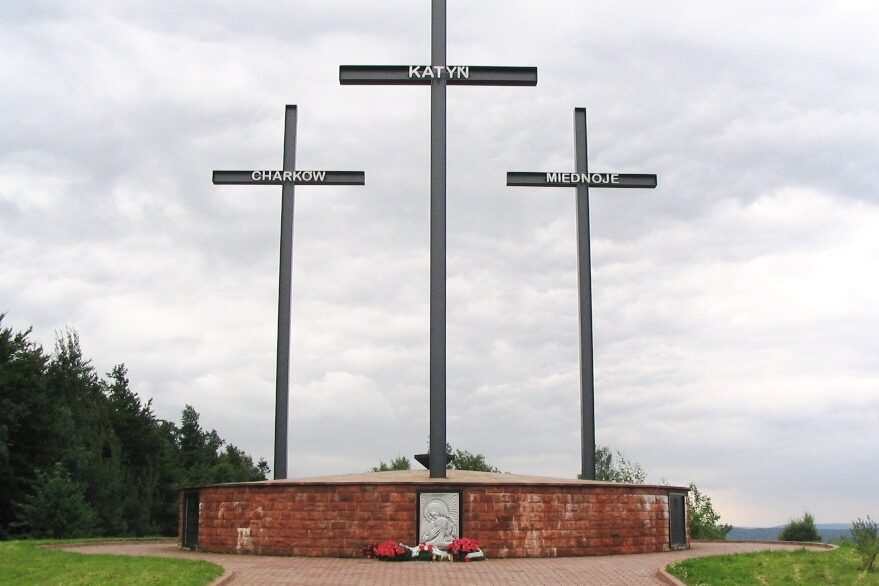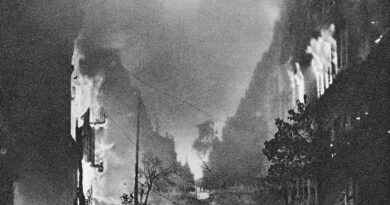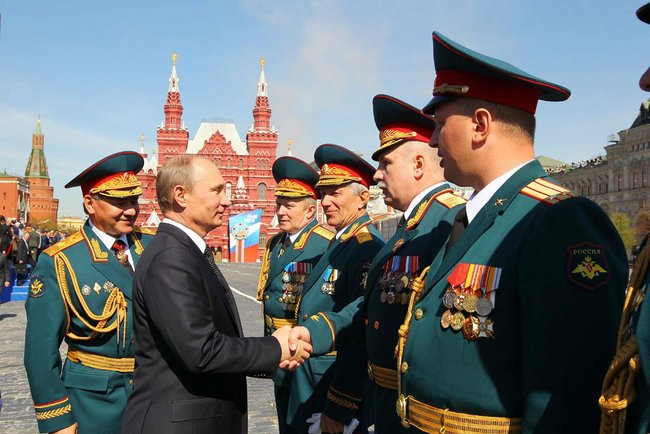On Stalin’s orders. This is how the Soviet Union murdered Polish officers in Katyn

The decision to murder Polish officers was taken by the Soviet dictator himself
Maciej Rosalak
This was a crime without a precedence in the history of the entire – so cruel – World War II. It had never and nowhere happened before that over twenty thousand of interned officers and officials from a neighbouring country would fell victim to a mass murder – and in such a beastly way. Even Hitler would not do that. But this is what the Soviet Union did to Poles who in the autumn of 1939 were incarcerated in three camps (Kozielsk, Ostaszków and Starobielsk) as well as in Soviet prisons. The murder is known as the Katyń massacre after the place (Katyń), where officers interned at Kozielsk were executed, and where traces of the massacre were found first.
They were not even prisoners of war. They surrendered to the Soviet Union after the Red Army invaded Poland without any declaration of war. Poles – in accordance with international law, and even USSR law standards – surrendered under the Soviet protection for defence against an invasion of another super power, the Third German Reich. They expected help and release after military actions stopped. What they got were shots to the back of their heads over death pits. Those who at the last moment realized they were led to the slaughter were beaten, prodded with bayonets, tied with ropes or barbed wire. Professor Nikita Pietrov from the Russian Memorial, an outstanding historian and a good man, described the massacre of Polish prisoners of war in the following way: “This was a physical extermination of a significant part of Polish elite. In particular, given that NKVD precisely explained who should be eliminated. The list included: Polish officers, officials, gentry, policemen, gendarmerie, settlers… And this alleged class struggle became in reality ethnical cleansing. Stalin understood it very well. Of course, when he signed those papers, the concept of a crime of genocide did not exist in legal terms. Today when we categorize German Nazi or Soviet totalitarian crimes under this term, we must say that the elimination of a significant ethnical group should be treated as genocide”.
Sentence
On 5 March 1940, seven dignitaries holding the highest positions in the hierarchy of the Soviet state together decided to carry out unprecedented genocide. They all were members of the Political Bureau of the Communist Party of the Soviet Union (Bolsheviks). The plan was put forward by Lavrentiy Beria, Minister of Internal Affairs. The decision was signed by the Bolshevik leader, Joseph Stalin, Vyacheslav Molotov, Prime Minister and Minister of Foreign Affairs, Anastas Mikoyan, Deputy Prime Minister and Klimient Voroshilov, Minister of Defence. The proposed plan was supported by the nominal head of state, Mikhail Kalinin, and by Lazar Kaganovitch, Secretary of the Political Bureau of WKP(b), who were not present at the meeting but who also signed the decision. Beria scribbled: “Execute!”.
Who was to execute what? Based on the decision and an order dated 22 March 1940, NKVD was to “review the cases” of 14.7 thousand Polish officers (camps in Kozielsk and Starobielsk), as well as officials, gentry, factory owners, policemen, settlers and prison guards (Ostaszków camp) and 11 thousand other officers, officials and members of the Polish elite, imprisoned in Ukraine and Belarus. “Review” was to be handled by three high-ranking comrades from NKVD: Vsivolod Mierkulov, Bogdan Kobulov and Leonid Bashtakov and was to be carried out based on a “special procedure allowing capital punishment”.
Based on information collected at camps and prisons during scrupulous interrogations and based on denunciations collected by the NKVD Administration for Prisoners of War, as well as Ukrainian and Belarus NKVD, during the autumn of 1939 and winter at the turn of 1939 and 1940, Poles interned in camps were given a special recommendation as “counter-revolutionary and hostile” towards the Soviet Union. This label was given to all those who declared loyalty to their homeland, Poland. This was sufficient to issue a sentence – without court, defence or even without informing those convicted. The three-person board appointed to review those cases were left with finding a solution to a practical question: in what order, on what day and in what number groups of prisoners of war and ordinary prisoners should be sent to death. Approximately 400 of those incarcerated stayed alive, so more or less one in every 30 people. This shows the indomitable spirit of a large majority of prisoners of war. The genocide was referred to in the command as “relieving” camps and prisons. This euphemism was hiding an order to transport and kill defenceless and innocent people and later to throw their bodies to a pit and cover them with earth.
Relieving camps
Comrades from the NKVD management proceeded to the task with great proficiency and expertise. Tasks were assigned by Kobulov and Piotr Soprunenko, Chief of NKVD Administration for Prisoners of War. Already after ten days from Politbiuro decision, those executing the order knew precisely what they were supposed to do and how they were to act, and so they did. They were members of NKVD executive boards of Smolensk, Kalinin and Kharkov Districts, in which executions were to be organized, as well as commandants, political commissioners and heads of special units from three camps to be “relieved”, and functionaries of NKVD convoy and transport units. Let us remember that both in Kozielsk, Ostaszków and partially in Starobielsk camps were organized in former cloisters.
In camps and prisons, detailed questionnaires were completed together with victim photographs. To cause the prisoners of war to relax their vigilance, they were vaccinated against typhus and cholera, in some cases, even x-ray pictures were taken; rumours were spread that soon they would be transported to France or Romania, and when the prisoners, full of hope, left, they got bread, sugar and herrings, packed – for the first time – in clean, new grey paper. After 16 March the prisoners were forbidden from sending private correspondence. By 25 March commandants of camps, heads of NKVD convoy and transport units reported they were fully prepared for the operation.
Yet already three days after Politbiuro’s murderous decision, the first transport of prisoners of war was sent – as a test – from Kozielsk to Katyń. On 15 March, 13 of them were killed there. Systematic extermination started in Katyń on 3 April, when 74 officers of the Polish Army were executed. Prisoners of war from Kozielsk were transported to the railway station at Gniezdowio near Smolensk. They were murdered in Katyń forest, over pits of death on Kozie Góry site, and probably also at a NKVD recreational mansion and NKVD offices at Smolensk.
The first group from Ostaszków was sent to death on 4 April. It consisted of 343 victims, who were killed at Tver (at the time: Kalinin).
On 5 April, 195 prisoners were transported out of Starobielsk. On the same day they were killed in Kharkov and buried in Piatichatki, a wooded district of Kharkov.
Killing shots were fired from Walther pistols, calibre 7.65 (Katyń, Tver) and Nagant revolvers, calibre 7.62 (Kharkov). In Kalinin and Kharkov prisoners were murdered on the underground floors of the local NKVD offices. Bodies of those killed in Tver were buried in the adjacent. Those killed in Kharkov – in Piatichatki.
Altogether 4410 prisoners of war from Kozielsk were killed in Katyń. The following persons lost their lives there: Counter Admiral Xawery Czernicki, Generals: Bronisław Bohatyrewicz, Henryk Minkiewicz and Mieczysław Smorawiński, as well as the chief Russian orthodox chaplain Lieutenant Colonel Szymon Federońko, chief rabbi of the Polish Army Major Baruch Steinberg and one woman – Second Lieutenant Pilot Janina Lewandowska.
In Kharkov, 3739 internees of Starobielsk were murdered, including eight Generals: Leon Billewicz, Stanisław Haller, Aleksander Kowalewski, Kazimierz Orlik-Łukoski, Konstanty Plisowski, Franciszek Sikorski, Leonard Skierski, and Piotr Skuratowicz.
In Tver, 6314 prisoners of war were murdered, mostly from the Polish Police and Prison Service.
Relieving prisons
Since 20 March, groups of NKVD staff, sent to prisons in our larger cities in the East, have prepared lists of people to be executed and delivered them for the “threesome”. On the next day, NKVD headquarters started to receive forms completed by them based on strictly defined instructions. Those sinister commando units of several functionaries were led by Paweł Mieszik (Lwów), Aleksiej Szkurin (Tarnopol), Anatolij Barminow (Stanisławów), Piotr Luferow (Drohobycz), Paweł Żurawlew (Równe), Samuił Kriwulin (Łuck) in Ukrainian borderlands, and Izrail Pinzur (Bialystok), Grigorij Filkenberg (Brest), Nikołaj Kożewnikow (Wilejka), Aleksander Kuprianow (Pinsk), Andriej Siniewow (Baranowicze) in Belarus borderlands.
On 22 March, Beria ordered to “relieve” prisons. Victims were first transported from former East Galicia and Volhynia to Kiev, Kharkov and Kherson. There, they were killed by the Soviet method – a shot to the back of the head, either in prisons or in adjacent wood areas, such as Bykownia near Kiev, known to us only recently. The bloody operation continued for two months and claimed the lives of no less than 7305 Poles. We know about them from the so‑called Ukrainian list because it was released to our prosecution office in 1994. It comprises 3435 names of Polish citizens. Among them there were 726 officers of the Polish Army (including seven generals), 770 police officers, and 28 members of prison staff. We know that there were 3870 names on the Belarusian list, but we do not know the details because either the list itself was lost or it is kept in the archives of Russian or Belarusian security police. We do not know either what happened to a similar number of Polish citizens, who probably fell victim – as proven by professor Krzysztof Jasiewicz – to murderous ethnic cleansing in other parts of the “inhuman land”.
And so died the flower of the nation – outstanding officers in active and reserve service, including many teachers and academics, doctors, lawyers, civil servants, gentry and businessmen, politicians. Many of them were around 40 years old. As young volunteers, soldiers, cadets and newly appointed officers, they crushed Bolsheviks in 1920 and chased them to the East. At that time, the political commissioner for the entire South-West Front of the Red Army was Joseph Stalin, who participated in the Bolshevik defeat. He not only wanted to eliminate the hostile element in ethnic and class-based terms, but also his vindictive nature must have called for revenge. And he acted as the worst type of a criminal: cowardly, blood-thirsty and having no respect for human life…
Katyń lie
Another crime was the lie, which acquitted Soviets of any fault, and was for a long time officially accepted by the West at a face value. It sullied the memory of victims, caused pain and further harmed their families; it allowed the Russians to propagate a false version of the World War II history, and finally, was the founding myth of the communist Poland. And this is how that lie, still accepted to be true by many Russians, was fabricated.
It can be traced back to 13 October 1940, to a conversation between NKVD bosses – Lavrentiy Beria and Vsivolod Mierkulov with Lieutenant Colonel Zygmunt Berling. The latter reminded them of the officers interned at Kozielsk and Starobielsk. Mierkulov got confused. – Oh no, he said. – We made a huge mistake with them… Beria did not let him finish: – They are not in the USSR – he cut the conversation short. In the autumn of 1941, the Vice Minister of the Soviet Ministry of Foreign Affairs told the Polish ambassador Stanisław Kot: “The number of 9.5 thousand Polish officers, allegedly remaining in the USSR, has not been confirmed. Such number of officers was never in NKVD’s records, also Defence Narkom (minister) denies it”. On 14 November, Stalin himself, questioned by Kot about this matter, asked by phone: “NKVD? Stalin calling. Have all Poles been released? Because I have the Polish ambassador here, who claims that not all were”. He hung up and said in a hushed tone, as if to himself: “They say that everybody has been released”. When on 3 December, General Władysław Sikorski inquired about the officers at Kremlin, Stalin stated: “They ran away”. Anders: “Where would they run to?”. Stalin: “Well, say to Manchuria”.
On 18 March 1942, Stalin told General Anders and his Chief of Staff, Colonel Leopold Okulicki: “I have already given all orders to release them. […] I do not know where they are. Why would I want to keep them? Maybe they were in camps in areas invaded by the Germans and ran away”. Okulicki: “This is not possible – we would have known”. Polish ambassador Tadeusz Romer calculated that from July 1941 to April 1943, Polish authorities submitted 50 official requests for help in finding the lost prisoners of war to various offices in the USSR.
In April 1943, after the Germans had discovered Katyń graves and after the Polish government had addressed a request to the International Red Cross to check the facts on site, Radio Moscow broadcasted the USSR government’s communique, in which Germans were accused of murdering Polish prisoners of war in 1941, and the discovered human remains were referred to as an “archaeological site”. Stalin, in his letters to Churchill and Roosevelt, accused the Polish government of collaboration with the Germans. Though Allies’ leaders did not agree with those accusations, but they criticized the involvement of the International Red Cross requested by the Polish authorities. On 26 April, the USSR broke off diplomatic relations with the Polish government in London.
On 1 May 1943, the official bulletin of the Polish Workers’ Party „Trybuna Wolności” (“Tribune of Freedom” ) published a statement of its Central Committee dated 23 April recognizing the Germans as perpetrators of the Katyń massacre, and the Polish government in London and the authorities of the Polish Underground State as “Goebbels’s henchmen”. This would be later sustained by the Polish communist government until the end of the 1980s, when Mikhail Gorbachev decides to admit USSR’s fault. The instruction given by the Polish communist Ministry of Public Security dated 12 March 1952 ordered the prosecution and indictment before court of “persons and groups propagating defamatory versions about Katyń”. Until 1956, 15 thousand Poles suffered repression for hostile propaganda, definitely concerning also Katyń.
The US government treated reports accusing the Soviets as classified and reprimanded Colonel Henry J. Szymański, a US Army liaison officer at the Polish Army in the Middle East (in 1943), and (after the war) Colonel John Van Vliet, who saw Katyń graves, when he was held captive by the Germans. On 18 November 1951, during the so-called Cold War, the US Congress House of Representatives appointed Ray J. Madden Commission, which after one year of research published an extensive report on its investigation and recommended – to no avail – to the US government to recognize that the murders were committed by the Soviets and to bring the matter to the International Court of Justice in Hague. Also the British ambassador to the Polish government-in-exile, Owen O’Malley, submitted a similar report to his government. The document remained classified until 1972.
On 24 January 1944, in a report of a commission appointed by the Soviets, Professor of Surgery Nikolai Burdenko maintained that in 1941, 11 thousand Polish prisoners of war were murdered in Katyń by the Germans. A year later, the lie was confirmed by terrorized professors Marko Markow from Sofia and Frantiszek Hajek from Prague, who stated the truth in 1943 during the works of the international doctors’ commission. At the beginning of July 1946, the Soviets filed an insolent request to the International Tribunal in Nurnberg accusing the Germans of the Katyń massacre. The Tribunal’s sentence of 30 September 1946 omitted the Katyń case. So the charges did not stand in court, but there was no willingness to charge the Soviets with the crime.



